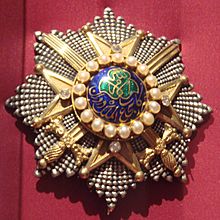Order of the Durrani Empire facts for kids
Quick facts for kids Order of the Durrani Empire(Nishan-i-Daulat-i-Durrani) |
|
|---|---|

1st Class Star awarded to Sir Thomas Willshire in the Musée national de la Légion d'Honneur et des Ordres de Chevalerie, Paris
|
|
| Awarded by Emir of Afghanistan | |
| Type | Order |
| Established | 1839 |
| Eligibility | British field officers |
| Awarded for | In gratitude for the restoration to the throne |
| Status | Obsolete |
| Founder | Shah Shujah Durrani |
| Grades | Grand Cross Grand Commander Companion |
Ribbon of the order |
|
The Order of the Durrani Empire (also known as Nishan-i-Daulat-i-Durrani) was a special award given in Afghanistan. It was created in 1839 by Shah Shujah Durrani, who was the ruler of Afghanistan at the time. This award was given to British military officers who helped him get his throne back during the First Anglo-Afghan War. It was a way for him to say "thank you" for their help.
Contents
Why the Order Was Created
The Order of the Durrani Empire was established in 1839. It was a way for Shah Shujah Durrani to show his thanks. He gave it to British field officers and others who helped him. They helped him return to his throne during the First Anglo-Afghan War.
First Award Ceremony
The very first time this award was given out was on September 17, 1839. It happened at a big ceremony called a durbar. This event took place in the courtyard of the Harem Serai. This area was part of the Bala Hissar fortress in Kabul.
Not all the awards were ready on that day. So, many variations of the stars and medals were made later. These were created in places like India and Europe. This is why you can see differences in the awards, especially in the number of pearls on them.
Different Classes of the Order
The Order of the Durrani Empire had three different levels, or "classes." This was similar to another famous award, the Order of the Bath.
First Class
The First Class award included both a medal and a star.
First Class Medal
The medal was a gold Maltese cross. It had eight points, each ending in a small gold bead. Two crossed swords were behind the cross. In the middle was a green flower on a blue background. Around this, in Persian writing, were the words "durr-i-durran." This means "pearl of the age," which was a name for the Durrani family. Pearls circled the colorful center.
First Class Star
The star was made of silver. It had a smaller gold Maltese cross placed on top. This cross looked just like the medal. Each arm of the gold cross also had a diamond. There were 17 pearls circling the center design.
Second Class
The Second Class award also had both a medal and a star.
Second Class Medal
This medal looked like the First Class medal. The main difference was that it had 20 pearls circling its center.
Second Class Star
The star was silver and shaped like a Maltese cross. It had the gold medal design placed on top, just like the First Class star. This star had 18 pearls around its center.
Third Class
The Third Class award only included a medal.
Third Class Medal
This medal was similar to the First Class medal. It had 14 pearls circling its center.
Ribbon for All Classes
All three classes of the award used the same ribbon. This ribbon was red and green. It was the same ribbon used for the Ghuznee Medal.
Notable Recipients
Many British officers received this special award. Here are a few examples of those who were honored:
First Class Recipients
- Lieut. General Sir John Keane
- Sir William Hay Macnaghten
- Major General Sir Thomas Willshire
Second Class Recipients
- Major General Sir James Outram
- Major General Sir Robert Henry Sale
- General Sir Joseph Thackwell
Third Class Recipients
- Major General Augustus Abbott
- Superintending Surgeon James Atkinson
- General Sir George St Patrick Lawrence

